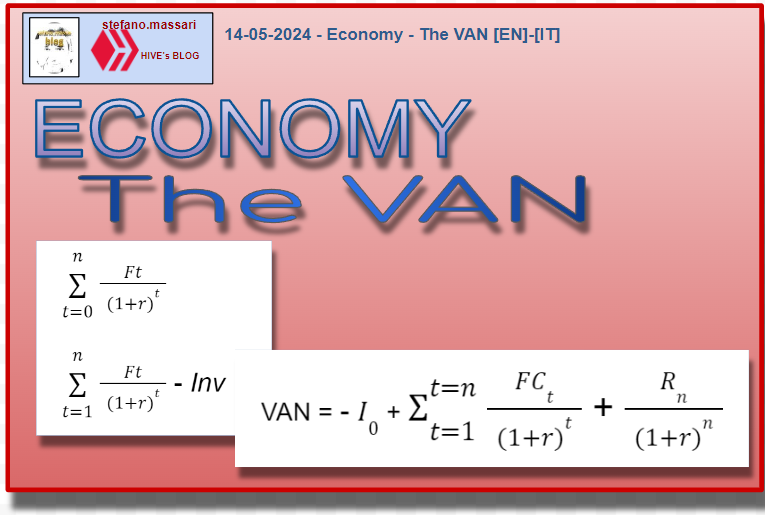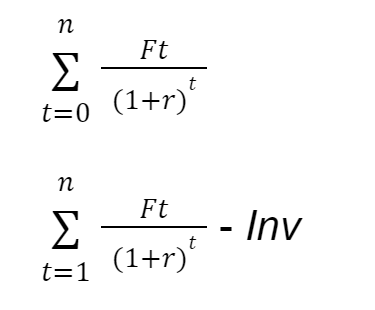14-05-2024 - Economy - The VAN [EN]-[IT]

~~~ La versione in italiano inizia subito dopo la versione in inglese ~~~
ENGLISH
14-05-2024 - Economy - The VAN [EN]-[IT]
The VAN
Definition
The acronym NPV stands for Net Present Value. This is a sort of economic indicator used to allow one to evaluate whether a given project is suitable for producing value.
This indicator is important because to measure the profitability of an investment project, it is necessary to verify whether it produces financial income.
Home represents
It represents the discounted value of an expected series of positive and negative cash flows generated by the investment.
Basically, this method, by comparing the initial cost with the future cash flows generated by the investment, essentially expresses the global financial balance (profit/loss) of the investment operation that is due to the entrepreneur, net of all costs supported, as if it were immediately available.
Cash flow
NPV takes cash flow into account. The following must be taken into consideration. An investment operation can be represented by an estimated succession of future monetary inflows and outflows, called "cash flow".
Therefore it is important to correctly estimate the cash flow to have a correct evaluation of the project.
In a project there are usually two phases, one is the initial one and the other is the secondary one. The initial phase is mainly characterized by financial outflows, the secondary phase is mainly characterized by income.
Considerations to make
Investments are considered to have the same duration and risk characteristics as the project under consideration. It is not correct to compare different values over time.
First basic principle of finance
The value of a certain sum of money today is greater than the value of the same sum in the future, and this is because money today can be invested and start paying interest immediately.
NPV formula
Below is the formula to calculate the NPV

Alternative NPV formula

I0 = initial investment
t = time interval
n= duration (number of intervals)
FCt = cash flow at interval t
r = discount rate
Rn = residual value (if any) at the last interval n
Note: The calculation aims to quantify, for all the years of the examined time horizon, the amount of financial resources that the project generates, net of investments.
Where:
-n number of years of project duration in which cash flows are generated;
-Ft = financial flow at time t (difference between positive and negative flows);
-r = interest rate;
-discount factor

When this index is high
This index is higher the closer the flows are in time, thus being less subject to the action of the discounting operation, the intensity of which increases as time increases (n)
Another reason why this index can be high is when flows are higher in absolute value.
Finally, this index will be higher the lower the interest rate, i.e. the opportunity cost.
Conclusions
The positive number of the NPV indicator indicates that the investment analyzed will be more profitable than an alternative investment made in a bank. Calculating the NPV is important because it allows us to understand whether it is better to invest in a business idea or simply it is better to invest in a financial product to earn more. In this last case it means that our project idea is not a good idea and it is not worth investing in it.
Request
Maybe you've never done an NPV analysis, but have you already thought in the past that maybe it would have been better to invest the money somewhere rather than investing it in an idea that didn't work out as hoped?

ITALIAN
14-05-2024 - Economia - Il VAN [EN]-[IT]
Il VAN
Definizione
L’acronimo VAN sta per Valore Attuale Netto. Questo è una sorta di indicatore economico usato per permettere di valutare se un determinato progetto è idoneo a produrre valore.
Questo indicatore è importante in quanto per misurare la redditività di un progetto d'investimento, è necessario verificare se questo produce entrate finanziarie.
Casa rappresenta
Rappresenta il valore attualizzato di una serie attesa di flussi di cassa positivi e negativi generati dall’investimento.
Sostanzialmente questo metodo, mettendo a confronto il costo iniziale con i futuri flussi di cassa generati dall’investimento, esprime in sostanza il saldo finanziario globale (profitto/perdita) dell’operazione di investimento che spetta all’imprenditore, al netto di tutti i costi sostenuti, come se fosse immediatamente disponibile.
Flusso di cassa
Il VAN tiene conto del flusso di cassa. Bisogna tenere in considerazione quanto segue. Un’operazione di investimento può essere rappresentata da una successione stimata di future entrate ed uscite monetarie, denominata “flusso di cassa”.
Quindi è importante stimare correttamente il cash-flow per avere una corretta valutazione del progetto.
In un progetto solitamente ci sono due fasi, una è quella iniziale e l’altra è quella secondaria. La fase iniziale è caratterizzata prevalentemente da uscite finanziarie, la fase secondaria è caratterizzata prevalentemente da entrate.
Considerazioni da fare
Si considerano investimenti aventi le stesse caratteristiche di durata e rischiosità del progetto in esame. Non è corretto confrontare valori tra loro differenti nel tempo.
Primo principio base della finanza
Il valore di una certa somma di denaro oggi è superiore al valore della medesima somma in futuro, e questo perché il denaro oggi può essere investito e iniziare a dare interessi immediatamente.
Formula del VAN
Qui di seguito la formula per calcolare il VAN

Formula alternativa del VAN

I0 = investimento iniziale
t = intervallo di tempo
n= durata (numero di intervalli)
FCt = flusso di cassa all’intervallo t
r = tasso di sconto
Rn = valore (eventuale) residuo all’ultimo intervallo n
Nota: Il calcolo ha lo scopo di quantificare, per tutti gli anni dell'orizzonte temporale esaminato, l’ammontare delle risorse finanziarie che il progetto genera, al netto degli investimenti.
Dove:
-n numero di anni di durata del progetto in cui si generano flussi di cassa;
-Ft = flusso finanziario al tempo t (differenza tra flussi positivi e negativi);
-r = tasso di interesse;
-fattore di sconto

Quando questo indice è elevato
Questo indice è tanto più elevato quanto i flussi sono ravvicinati nel tempo, essendo così meno soggetti all’azione dell’operazione di sconto, la cui intensità aumenta al crescere del tempo (n)
Un altro motivo per cui questo indice può essere elevato è quando i flussi sono più elevati in valore assoluto.
Infine questo indice sarà tanto più elevato quanto minore è il tasso di interesse, ovvero il costo-opportunità.
Conclusioni
Il numero positivo dell’indicatore VAN ci indica che l’investimento analizzato sarà più redditizio rispetto ad un investimento alternativo fatto in banca. Calcolare il VAN è importante perché ci permette di capire se è meglio investire in un'idea d’impresa oppure semplicemente è meglio investire in un prodotto finanziario per guadagnarci di più. In questo ultimo caso vuol dire che la nostra idea di progetto non è una buona idea e non conviene investirci sopra.
Domanda
Magari non avete mai fatto un'analisi VAN, ma avete già pensato in passato che forse sarebbe stato meglio investire i soldi da qualche parte anziché investirli in un idea che poi non ha funzionato come sperato?
THE END
Can NPV work without cash flow or cash has to be needed to achieve that?
La tua domanda mi fa pensare: alcune persone vendono le loro criptovalute, poi aumentano di valore, è lì che inizia il problema, ecco perché penso che nel momento in cui hanno venduto hanno realizzato un profitto, quindi è stato positivo.
Quando guardiamo indietro, è meglio guardare in modo positivo, cercare di correggere i nostri errori, finché sono errori, dobbiamo analizzarli bene prima di assegnargli questa categoria.